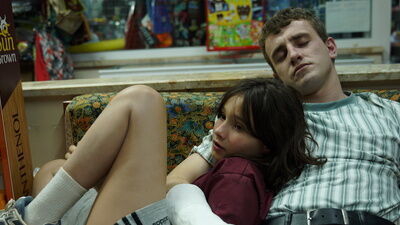“Aftersun” is clearly told from Sophie’s point of view, but a perceptive viewer will notice there are scenes where Sophie is not present. The film, then, is from the adult Sophie’s point of view, an adult—a new parent herself—looking back on this vacation, curious about what her father must have been going through. She knows her own memories of the vacation. But what was going on with him?
Wells intersperses the vacation with surreal dream-like “rave” sequences, where an adult Sophie (Celia Rowlson-Hall, whose 2016 directorial debut “Ma” I so admired and reviewed for this site) stands on a crowded dance floor, catching glimpses of her father writhing to the music in the intermittent lightning flashes of the strobe lights. She wants to get to him, touch him, hold him. Sophie is an adult now. She understands him so much better now. What would it be like if she could talk to him? They would still have so much to say to one another. In a way, “Aftersun” is an act of imaginative empathy. Sophie can now look at the things that child Sophie could not see.
This once-removed point of view, this slightly distanced stance, gives the film its melancholy melody of an almost elegiac sweetness. In the present moment, all is sunshine and laughter, Calum and Sophie having ice cream, getting mud baths, swimming, where it doesn’t matter that the resort is cheap and there’s construction going on. What matters is being together. Mescal (so wonderful in “Normal People”) gives such a tactile earthy performance, grounded in the details. There are fleeting glimpses of worry and self-loathing, his fears about not being good enough, not being a good provider or failing her … all of the things he feels he must hide—and, for the most part—does hide.
Frankie Corio is a newcomer. She’s alert, sensitive, and a totally natural presence. The dynamic between Corio and Mescal is nothing short of amazing—they are so comfortable with one another! They’re playful and thoughtful, they get joy from one another, but are capable of hurting one another too. This dynamic is a tribute to both Mescal and Corio, of course, but also a tribute to Wells’ gifts in both casting and working with actors.
Cinematographer Gregory Oke uses a soft rich palette, summery and saturated, and often keeps the frame off-center, destabilizing the point of view. Calum is often seen through a doorway, or as a reflection—in a mirror or a television screen—obscured, half-there, half not-there, similar to adult Sophie’s glimpses of him at the rave: the strobe is so violent, it’s impossible to see him in full, to perceive him as there and in the flesh. Sound designer Mehmet Aksoy also does fine work, particularly in a scene when Calum stalks down to the beach in the middle of the night for a swim. Calum is swallowed up by the blackness, and the gentle lapping of the waves slowly crescendos to the sound of thundering surf.
Sumber: www.rogerebert.com
 Skip to content
Skip to content






